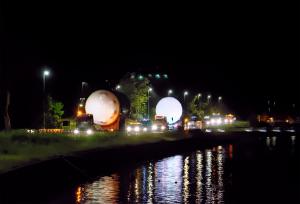Home at last
18 May 2015
-
R.A.
There's a strange beauty to the transport of ITER components. It comes from the revolving lights piercing the night, from the slow progress of the trailer and its escort of a dozen vehicles, from the deserted roads and sleeping villages...
For three nights, from 4 to 7 May, the second Highly Exceptional Load (HEL) to be delivered to ITER made its way along the ITER Itinerary. A few minutes past 3:00 a.m., on Thursday 7 May, two large trailers—each loaded with a 79-ton cylindrical tank—passed the gate of the ITER site.
Five weeks after the US-procured components had embarked for their transatlantic voyage and 11 days after they were unloaded at Marseille's industrial harbour in Fos-sur-Mer, the tanks had reached their home at last.
The final leg of the voyage, from the village Meyrargues to the ITER site, was uneventful—which is the best possible result for such a delicate logistics operation. The schedule was respected and even improved by half an hour. By mid-afternoon both tanks had been unloaded and carefully stored into the large hangar at the entrance to ITER Headquarters.
Out in the open they resembled giant beer kegs. In the hangar, they looked like the segments of a star-bound rocket.


